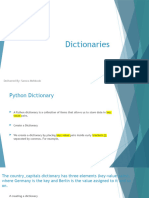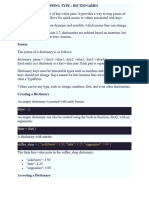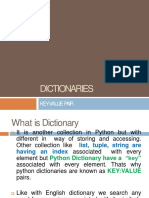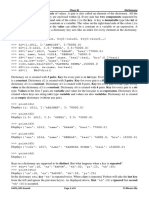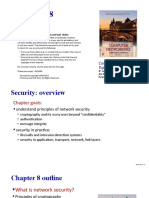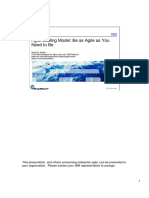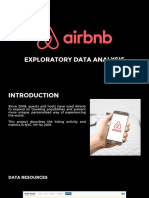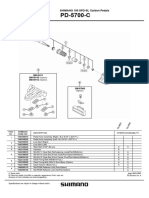Python Dictionary
Python Dictionary
Python Dictionary is a collection. It can contain multiple elements.
Python Dictionary is un-ordered. The elements in the dictionary are not stored in a sequence. For example, if
you add an item to a dictionary, it can be inserted at any index.
Python Dictionary is changeable. You can update an item using its key, delete an item, or add an item. The
original dictionary gets updated. Simply put, Python Dictionary is mutable.
Python Dictionary is indexed. You can access a specific key:value pair using key as index.
Create a Python Dictionary with Initial Values
To create a python dictionary, assign a variable with comma separated key:value pairs enclosed in curly
braces.
In the following example, we create a dictionary with some initial key:value pairs.
#initialize tuple
aDict = {
'tallest building':'Burj Khalifa',
'longest river':'The Nile',
'biggest ocean':'The Pacific Ocean'
}
In the above example, tallest building , longest river and biggest ocean are keys while Burj Khalifa ,
The Nile and The Pacific Ocean are their corresponding values.
Access Specific Key:Value Pair
To access a specific key:value pair in a dictionary, use key as index on the dictionary.
#initialize tuple
aDict = {
'tallest building':'Burj Khalifa',
'longest river':'The Nile',
'biggest ocean':'The Pacific Ocean'
}
print(aDict['longest river'])
Output
The Nile
Iterate through key:value pairs of Python Dictionary
To iterate through all key:value pairs of a Python Dictionary, you can use for loop as shown below.
#initialize tuple
aDict = {
'tallest building':'Burj Khalifa',
'longest river':'The Nile',
'biggest ocean':'The Pacific Ocean'
}
for key in aDict:
print(key,':',aDict[key])
Output
tallest building : Burj Khalifa
longest river : The Nile
biggest ocean : The Pacific Ocean
Add a new Key:Value Pair to the Dictionary
To add a new key value pair to the dictionary, just assign the value to the dictionary using key as index.
#initialize tuple
aDict = {
'tallest building':'Burj Khalifa',
'longest river':'The Nile',
'biggest ocean':'The Pacific Ocean'
}
aDict['biggest forest'] = 'The Amazon'
for key in aDict:
print(key, ':', aDict[key])
Output
tallest building : Burj Khalifa
longest river : The Nile
biggest ocean : The Pacific Ocean
biggest forest : The Amazon
Dictionary Operations
You can perform many other operations on Dictionary. You can refer these following tutorials for different
operations available on a Python Dictionary.
Get Keys of Python Dictionary as a List
Get Values of Python Dictionary as a List
Remove all elements of a Python Dictionary
Get Length of Python Dictionary
Compare two Python Dictionaries
Conclusion
In this Python Tutorial, we learned how to initialize a Dictionary in Python, how to iterate through the key:value
pairs of the dictionary, how to add a new key:value pair to the dictionary and many other operations that could
be performed on a Python Dictionary.
Python Programming
⊩ Python Tutorial
⊩ Install Python
⊩ Install Anaconda Python
⊩ Python HelloWorld Program
⊩ Python Variables
⊩ Python Variable Data Type Conversion
⊩ Python Comments
Control Statements
⊩ Python If
⊩ Python If Else
⊩ Python While Loop
⊩ Python For Loop
Python String
⊩ Python String Methods
⊩ Python String Length
⊩ Python String Replace
⊩ Python Split String
⊩ Python Count Occurrences of Sub-String
⊩ Python Sort List of Strings
Functions
⊩ Python Functions
Python Collections
⊩ Python List
⊩ Python Dictionary
Advanced
⊩ Python Multithreading
Useful Resources
⊩ Python Interview Questions




















